Text
youtube
A very thought provoking discussion here where I want to offer two gentle critiques. The way these two Catholic thinkers, perhaps in a moderately conservative perspective, engage these topics is valuable for how they consider the philosophical and existential issues we face today. These two Catholic thinkers, Bishop Robert Barron and Professor Patrick Deneen, recognize the relativistic moral landscape that has been at least partially responsible for the social anxieties that many of our youth face. They recognize that the tired conservative/liberal positions offer no real solutions and are contributing to this social reality.
The youth are indeed struggling with this and I applaud these two thinkers for raising the issue and offering a solution that can be found in the Catholic social tradition: a universal standard of virtues and moral framework for our social and political order. A standard that will have meaningful implications for the diverse community of youths as they recreate a new social order.
But their moderately conservative positions betray two important shortcomings that must be addressed.
These two thinkers seem to be blaming modern liberalism as an inherently flawed philosophical system that is responsible for the issues we face. That would be fine if what they defined in the first ten minutes of the video was political liberalism... But it is not! What they, as a point of fact, are defining is libertarianism. That is the current political idea that has gained tremendous traction from those who lived in the 1960's and 1970's. These are the dominant ideas that have dictated contemporary conservative policies (socially and economically) and contemporary liberal policies (poltically and civily). What is missing from this dialogue is the element of liberalism that is very much part of its definition, the idea of contractarianism, the social contract.
Bishop Barron seems to look for a recovery of the "pre-hobbesian sense of the good." He looks for a recovery of the past moral framework and he asks Deneen for signs of hope where this could be found. Deneen does not actually respond to this question directly, he instead tells us that most people are not satisfied with the current system and that the young students seem to be the most restless. They do not see a "pre-hobbesian" ideal because that is not emerging. However, what is emerging is a new contextual framework that can and I believe will construct a new universal standard for virtues and moral framework based not on a universal ideal that was defined by Western philosophy and housed in European Universities. What is emerging is a theological and philosophical framework that is emerging from diverse voices from the global south as well as the north. This is the great contribution of contextual theology that is unfortunately dismissed by conservative thinkers without realizing that therein lies the seeds of hope they are seeking.
To respond to the first issue, Lockean Liberalism was not based on the premise that we ougth to exist in a state of absolute freedom, again that is libertarianism. Locke believed that the people must exist within a social contract, a social contract that retained and protected certain individual rights (life, liberty, and property). If the government becomes tyrannical and abuses those rights then the people are not obliged to follow the contract but so long the Government fulfills this obligation than the contract is the law of the land. Lockean liberalism is not relativistic license to do as you wish (as is implied above) but the adherence to the basic premise of human dignity and community participation/subsidiarity, two essential componants of Catholic social teaching.
To further appreciate the ideals of liberalism we should also consult John Rawls. For Rawls, liberalism is a system of justice (fairness) that is attentive to the values of liberty and equality. The following two principles are offered which regulates this system and keeps it from developing into a libertarian (free for all) position. (Rawls, pg. 5)
Each person has an equal claim to a fully adequate scheme of equal basic rights and liberties, which scheme is compatible with the same scheme for all; and in this scheme the equal political liberties, and only those liberties, are to be guaranteed their fair value.
Social and economic inequalities are to satisfy two conditions: first, they are to be attached to positions and offices open to all under conditions of fair equality of opportunity; and second, they are to be to the greatest benefit of the least advantaged members of society.
So to the values of dignity and participation we can add the common good and the preferential option for the poor as part of Rawlsian liberalism. What is necessary now, what our two thinkers are struggling with above, is to consider the ideological basis for values and a moral framework. This leads to my second critique.
There is a philosophical error when it is thought that a social framework must be found by recovering some past value-based ideal. The error that is being made is that the concept of cosmopolis is not being recognized. I have talked about this concept in the past, and in the future, I hope to further promote this concept that I first discovered when I read Stephen Toulmin's book titled "Cosmopolis." According to this principle, the state of nature plays an implicit role in dictating how we understand our social systems. How we understand the governing principles of our cosmology guides how we also understand the principles that govern our social system. The ideals of capitalism and communism were both informed by a Newtonian model, and that is why the young do not connect with it. We no longer live within that cosmological framework. We live in a universe governed by general relativity, quantum mechanics, and string theory.
Barron and Deneen correctly recognized that the youth are very much agitated, depressed, and in a state of anxiety. Furthermore, they are right in saying that the former conservative/liberal arguments are no longer addressing their angst. But instead of thinking that the solution lies in some past ideal what they need to do is to read the "signs of the times" and consider how the ideological solutions may instead be found in the creative and dynamic theological and philosophical value based frameworks that can be found in contextual theologies/philosophies. Asian, African, Latinx, women, and minorties are developing their own epistomological definition of meaning and happiness. Having these reworked within the liberal contributions of Western society may offer a value-based moral/ideological framework that can give the youth a universal standard for values and social ethics.
Unfortunately this is not recognized by conservative voices including the fairly moderate position exposed by these two white men we see before us. But they do see the problem and through the lens of the Catholic American tradition (which they know very well) they correctly recognize the immense value that our Catholic social tradition has in contributing to a new (rather than a recovered) universal standard. As they point out, the Catholic American tradition recognize that "The founders built better than they knew." I think our Catholic American tradition is correct in making this claim. The founders may have had a culturally limited framework but their liberal (again, not libertarian) design allowed them to create a system that could emerge and adapt to the times. As we can see when we visit the Thomas Jefferson Memorial.
I am not an advocate for frequent changes in laws and constitutions, but laws and institutions must go hand in hand with the progress of the human mind. As that becomes more developed, more enlightened, as new discoveries are made, new truths discovered and manners and opinions change, with the change of circumstances, institutions must advance also to keep pace with the times. We might as well require a man to wear still the coat which fitted him when a boy as a civilized society to remain ever under the regimen of their barbarous ancestors.
The American experiment is far from over, Our founders had the wisdom to create something that could be creatively adapted over and over to the changing times. The two Catholic thinkers above offer us insights for a social conversation we need to have. But we perhpas clarify our liberal tradition and be more open to the idea of cosmopolis and contextual voices.
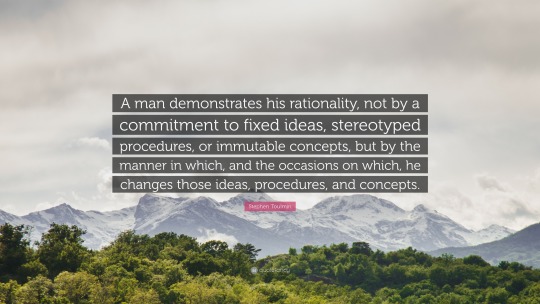
0 notes
Text
youtube
Historians of America Unite!!!
Ken Burns is the famed documentarian that has made a number of amazing movies which I have in my personal library. His most well known documentary is "The Civil War."
I have nothing but deep respect for Ken Burns and his historical contributions. I am a theologian/social minister myself but as a hobby I dabble as an historian and have been given the opportunity to teach Church history. My historical passions are mostly related to classical Western, early and medieval Church, medieval Spanish, and American history. As an armchair historian, I found Ken Burns' insights during this speech very thought provoking. I want to share three insights that he offers in his recent speech to the graduates of Brandeis University. His first insight is this:
The best arguments of the world, and ladies and gentlemen that is all we do is argue, The best arguments won't change a single person's point of view, that only thing that will change that is a good story.
The story, the narrative, is what moves people and rightly so. On another post Fr. Casey presents on this by engaging with the show "conspiracy road trip" and seeing how people can gain perspectives by engaging the personal narrative.
Certainly, many of us can share the narratives of our own encounters with others. But for someone to attain the full force of the narrative, they will need to have their own personal encounter. This is what I attempt to promote at the level of parish social ministry, a personal encounter with those in need.
This connects with a second insight that Ken Burns gives towards the middle of his speech. Never allow yourself to be part of community that speaks of "them." The social construct of "them" is divisive. As a documentarian Burns discovers that there is no real "them," there is only us. Historians become aware of how relative the notion of "them" is because these tribal identities are always fleeting when seen through the lens of time. Instead, the use of "them" is simply a social construct that limits who we are as a community. "Othering," Ken Burns tells us, "is the simplistic binary way to make and identify enemies, but it is also the surest to your own self-imprisonment."
Finally, Burns raises the notion of the "kinship of our soul." A notion described by the novalist Isaac Bashevis Singer. Recognizing that his writings touched so many people, Singer realized that his story spoke of the "kinship of the soul." Burns describes this as "the indefinable something that connects all of us together, that which we all share as part of organic life on this planet." Catholic social teaching identifies this within the principles of solidarity and the integrity of creation.
It is with these insights that Burns can no longer maintain his political neutrality. This November, he tells the graduates, "There is no real choice."
The presumptive Republican nominee is the opiod of all opiods, an easy cure for what some believe is the solution to our myriad pains and problems. When, in fact, with him, you end up re-enslaved with an even bigger problem; a worst affliction and addiction, a bigger delusion, as James Baldwin would say. The author and finisher of our national existence, our national suicide, as Mr. Lincoln prophesied. Do not be seduced by easy equalization, there is nothing equal about this equation. We are at an existential crossroads in our political and civic lives. This is a choice that could not be clearer.
I am so very thankful that Ken Burns took the bold step to relinquish his objective neutrality when the lessons of history inform us of the clear danger we politically face.
It is up to us historians (amateur or professional) to shed some light on the lessons of history and the dangers we face as we look to repeat certain historical tragedies. The current anti-immigrant position is one that requires such an analysis. Below, I share a thoroughly researched article that I found in the Washington Post. In going over the historical survey of immigration in the United States It's core findings is that:
Despite continued attempts to preserve the nation’s White European identity, immigrants today come from a diverse range of nations, mostly in the Global South.
100 years ago the U.S. tried to limit immigration to White Europeans. Instead, diversity triumphed.
This article does an amazing job in describing how America's Western and Northern European immigrants viewed with amazing contempt those who were outside of their ethnic composition. The attempt at limiting immigration and promoting eugenic experiments is part of our own tragic legacy that we must never forget. But underlying all this is a very racial and discriminating perspective that is part of our national sin. A sin that many who support the presumptive Republican nominee may not want to publically recognize but must, at some level, reckon as part of the underlying factor for our anti-immigration policies.
There can be “no doubt that if America is to remain a stable nation it must continue to be a white man’s country for an indefinite period to come,” sociologist Henry Pratt Fairchild wrote in 1926. “An exclusion policy toward all non-white groups is wholly defensible in theory and practice, however questionable may have been the immediate means by which this policy has been put into effect at successive periods in our history.”
Learning history should not be embarrassing. We gain a deeper perspective as we become aware of the great achievements we made while also learning from our mistakes. The MAGA movement doesn't seem to want to learn from its past but rather to repeat it. This willful ignorance will lead America into an existential crisis. Like Ken Burns, I believe we cannot afford to remain neutral this November.
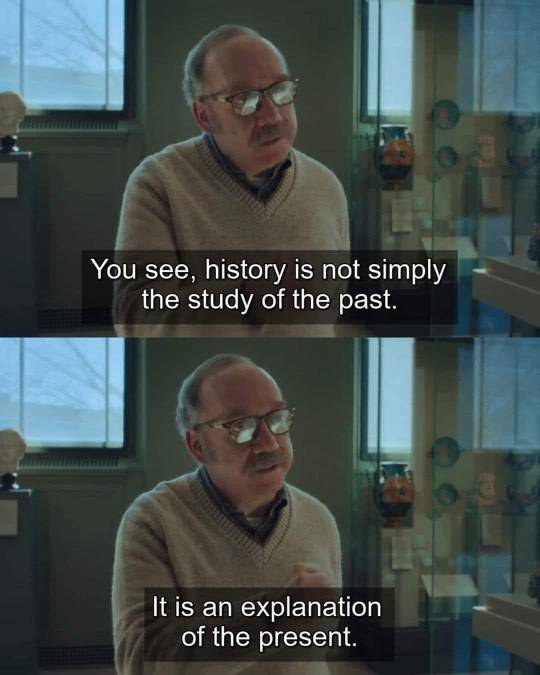
0 notes
Text
"If a foe from within strike a blow at her glory,
Down, down, with the traitor that dares to defile the flag of her stars and the page of her story!" - Star Spangled Banner (unsung 5th verse)
CNN recently shared an appropriate memorial day story about the need to see the American flag as a non-partisan symbol. This may seem obvious, but as I considered the current political climate, I also realized that this message very much needed to be said.
Smerconish offers a valuable insight here as he recognizes how this symbol of our Country seems to have become co-opted (and perhaps redefined) by the conservative community.
Flying our flag shouldn't mean you support any particular candidate, nor should it imply that you are wholly satisfied with the direction of the country. You can be disappointed in the current climate and in the current candidates, most are. It doesn't mean you love the country any less. It just means that you want to fix it. And thank God we have a country that allows us a process to resolve our differences. Protecting that framework needs to be our highest priority.
I could not agree more with Smerconish. The flag is the preeminent symbol of this nation. It symbolizes how we define ourselves. To allow it to be flown by only a particular group who is redefining it with a narrow conservative/libertarian slant is a betrayal to the liberal and communal ethos, which originally defined this symbol of our nation.
The time between Memorial Day and the 4th of July is a great time for Americans to reflect on who we are. In the past, I have said that as nice as fireworks and barbecues are, what is really needed is a time dedicated to reflecting on who we are as a nation. Our Declaration reminds us our liberal values in the second paragraph and our communal ethos in the last paragraph.
This year I want to also raise the fifth and sixth verse of the Star Spangled Banner that was written by the famed poet Oliver Wendell Holmes after the Civil War. It integrated the way the flag struggled to defend its authentic values from those who would pervert it for their own interest. Please watch and reflect on this beautiful verse below.
youtube
By the millions unchain'd who our birthright have gained,
We will keep her bright blazon forever unstained!
And the Star-Spangled Banner in triumph shall wave,
While the land of the free is the home of the brave.
The Liberal, progressive, and minority communities can (and I think should) champion officially inserting these lost verses. We must recognize that it was culturally cancelled by those who were embarrased at the loss of the Civil War and the resulting constitutional amendments banning slavery and (eventually) racial discrimination. In this great conflict the Star Spangled Banner stood for the core of our American values within the infrastructure of the Union, a centralized government with a liberal tradition where we would truly recognize the ideal of universal equality.
The American experiment is not over. The struggle for truly believing and promoting these values continues to this very day. This is an ongoing struggle for a new generation: disenfranchised youth, migrants and refugees, minorities, and other marginalized communities. Their struggle will hopefully not be as violent as the Civil War but they will face a struggle all the same. We dare not forget or dismiss the lessons of our past as we address the current reality. These verses would contribute to our appreciation of all that the flag truly stood for.
This is what the Star Spangled Banner is all about, let's bravely fly her and proudly reimbue her with these liberal and communal values from those who dare to contaminate her with their own ideals and self-interest.
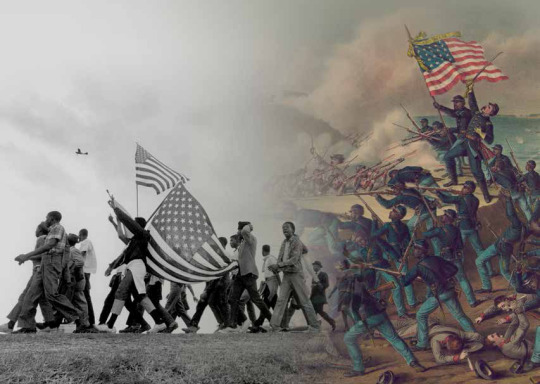
0 notes
Text

A Progressive Catholic!
While I do claim to be a progressive Catholic, I often find myself thinking, how can a Catholic be anything but progressive.
Let me qualify this: I am not referring to progressive within a mere political definition (although it does infer this). Instead, I am referring to the definition of progressive as both generally open and forward looking. The basis of our faith is in the mission that Jesus preached and lived in this world. He preached a Kingdom of God message that is both here (in his very life) and not yet (a future where all will be one in God). We pledge our faith in "the life of a world to come. Amen." The very basis of our faith is based on Christ's mission that is both open and forward looking.
And I have given them the glory you gave me, so that they may be one, as we are one, I in them and you in me, that they may be brought to perfection as one, that the world may know that you sent me, and that you loved them even as you loved me. - John 17:22-23
How are we missing the progressive thrust of Jesus' message and mission.
Yes, we look towards Jesus, and in celebrating his last supper, we recall his words consecrating the bread and wine into his own body and blood as he reminds us to "do this in memory of me." This certainly looks to the past, but it does not keep us on the past. Our life in Jesus and even in maintaining the memory of Jesus us for the purpose of strengthening us in promoting his progressive mission. In serving one another and reconciling all people into himself as we work with Christ and the Church in building the Kingdom of God.
So yes, I agree with Pope Francis, a staunchly conservative mentality is very limiting. It is incapable of participating in the forward-looking mission of reconciling all people to God.

0 notes
Text
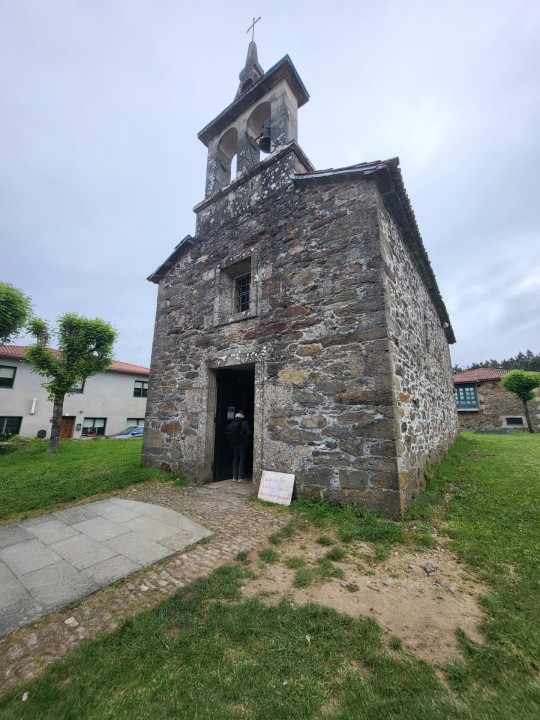
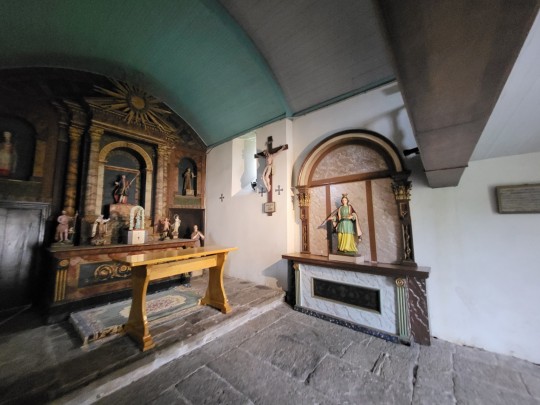


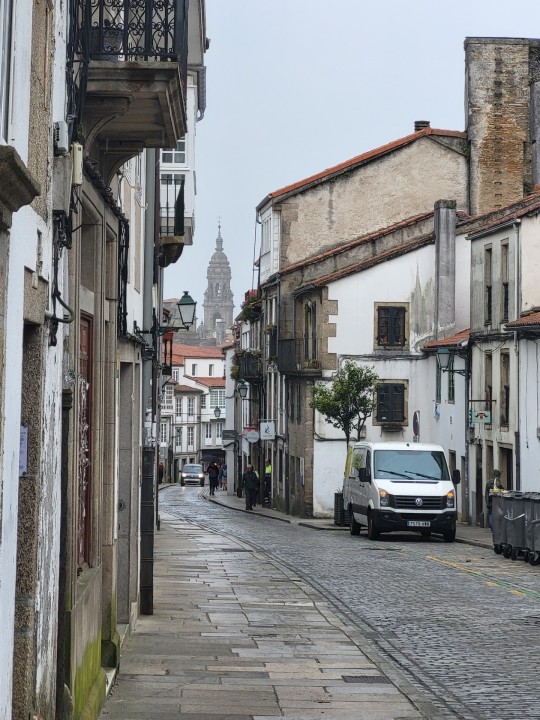


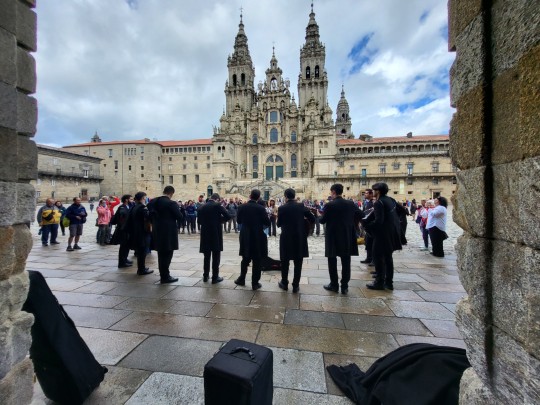
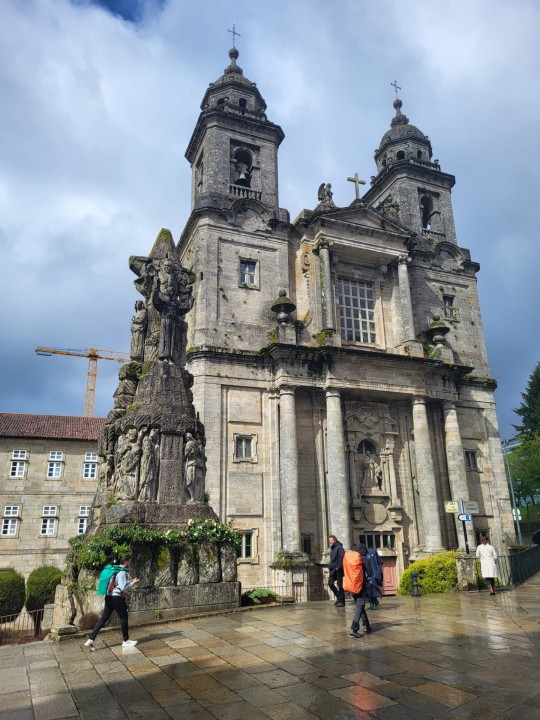
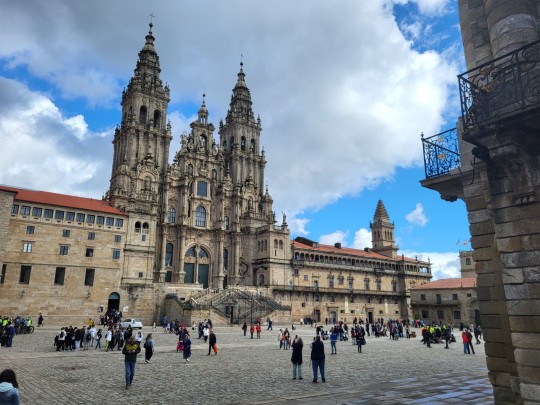
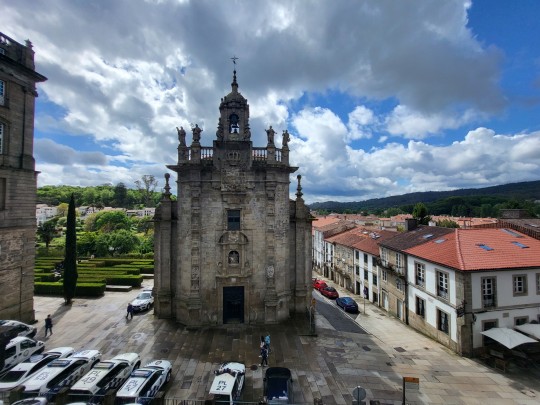
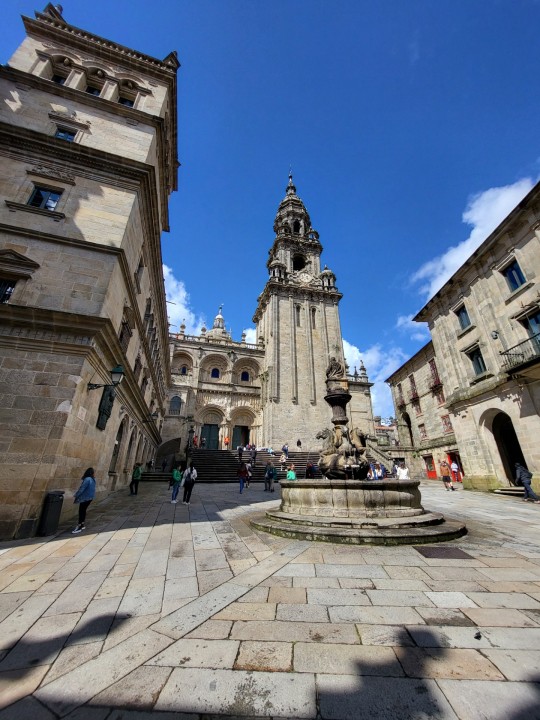

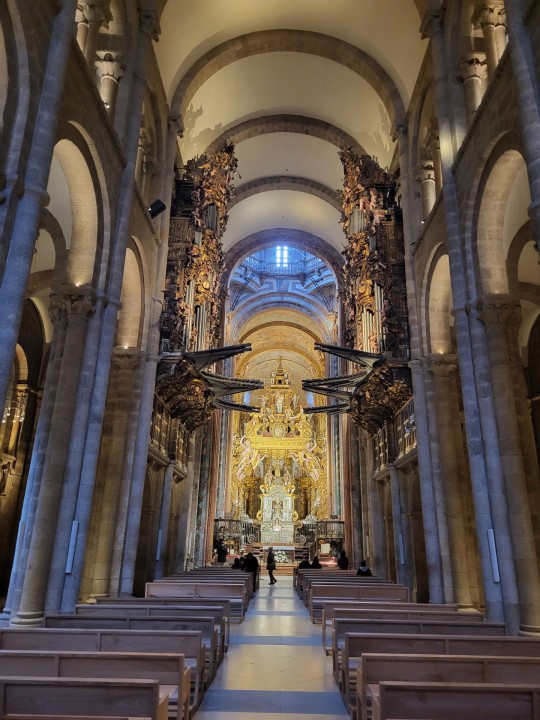

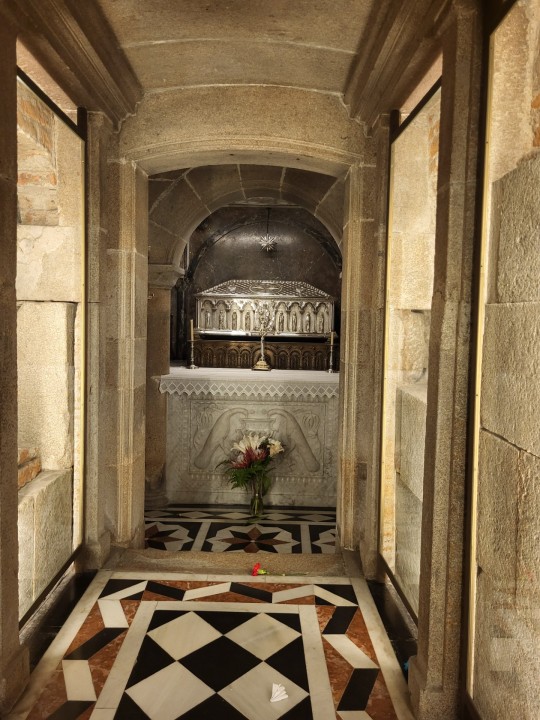
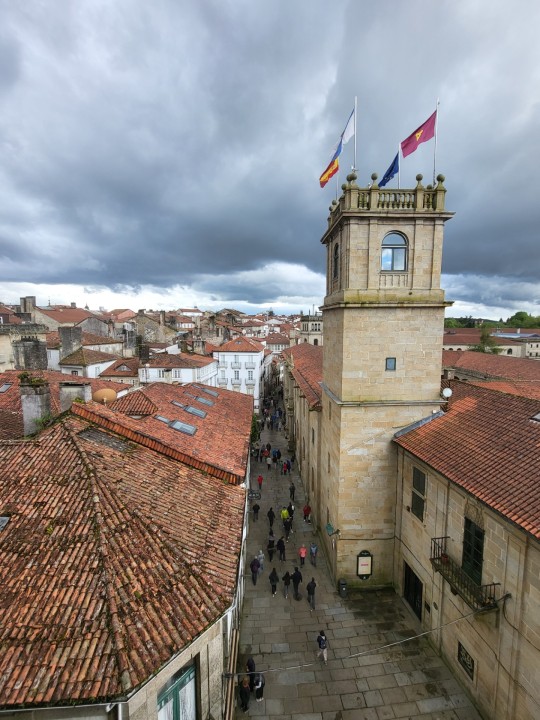
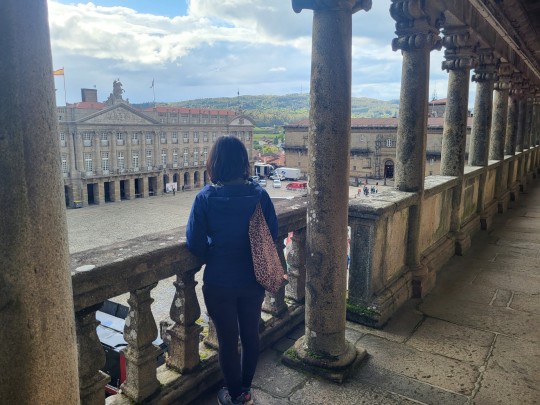
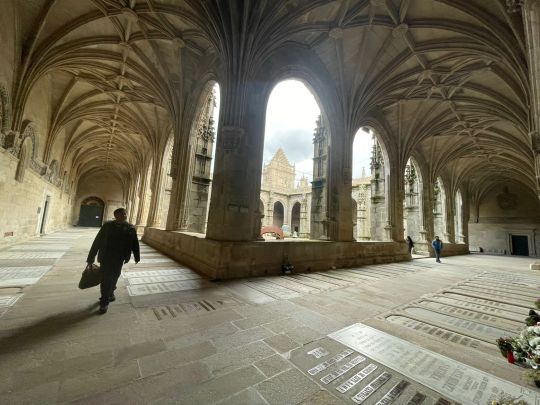
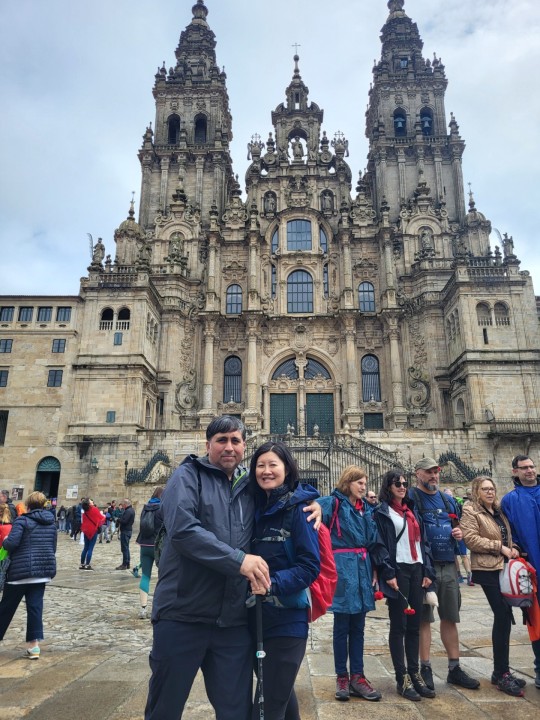
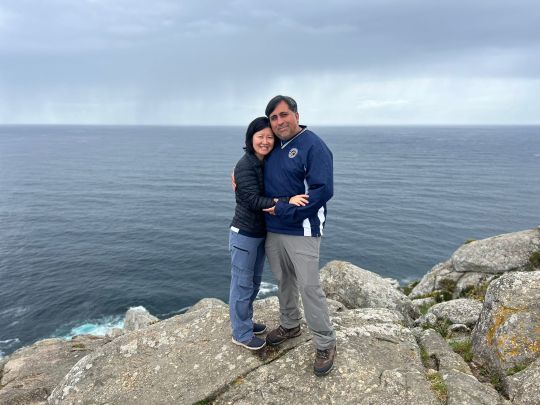



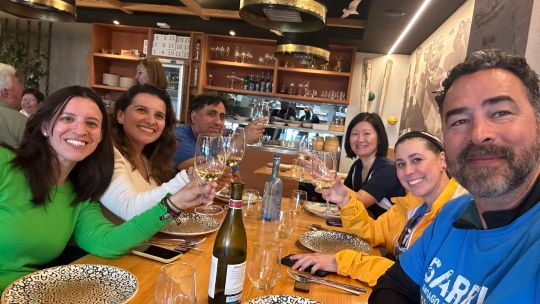

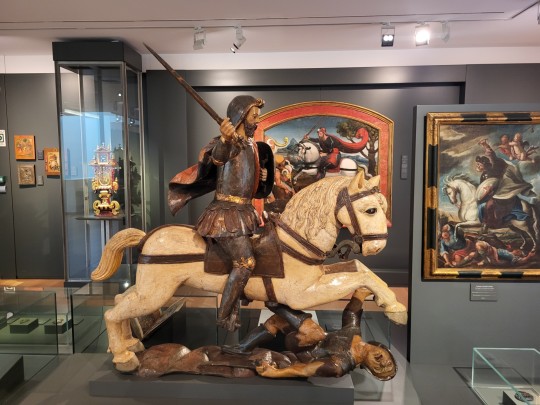

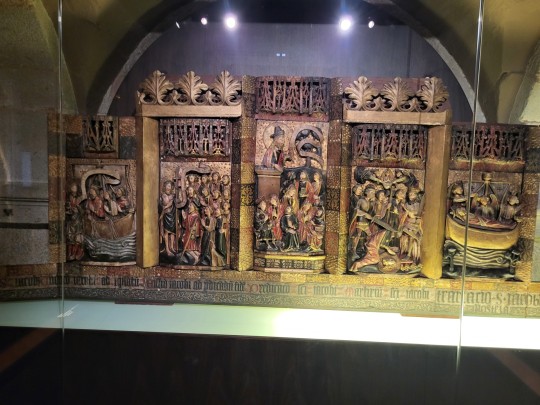

En El Camino: Our Pilgrimage to Compostela (part 2)
We walked on average 22km a day to Compostela and on the last day we only had 15km left so we felt that our destination was just a hop, skip, and a jump away. That was not the case. The last segment of the journey felt long and painful. Wendi and I did not talk much on the journey as I recalled as we focused on our individual pain and the goal of getting to our destination. Here are some reflections and insights I will share as we reached the Cathedral, the sacred goal of our camino.
In the first two pictures I stopped at the chapel of St. Lucy, the patron of eyesight. I touched the statue as an act of simple veneration and left. I received the sello (seal) and continued on the path. As I walked on, I heard the passage from the Gospel of John chapter 9 verse 41 recited to me a couple of times. This is where Jesus rebukes the Pharisees for questioning his healing of a blind man. Jesus tells them, “If you were blind, you would have no sin; but now you are saying, ‘We see,’ so your sin remains." I had to consider what this said to me and it made me think about how I intend to conclude my book on social ministry. It spoke to me of the temptation that social justice ministers have in presuming to know what is just and fair and how we can sometimes lose our faith and hope for a just world. Here I have been a person who claims to see, to be the arbiter of justice and equality. My concluding chapter is on having hope and this insight was a reminder from Jesus that we need to let go of our ideals and allways remember that the Kingdom of God is a vision and mission that transcends our own limited socio-political aspirations.
In the third picture we had reached the mountain of Gozo (joy). This is the place where pilgrims see for the first time the town of Compostela. We walked down to the town itself and the fourth and fifth picture shows parts of the town itself. It felt rather ordinary to be honest. It was a great sigh of relief to feel that we had reached our goal but the goal itself did not feel particularly special. I was in awe of the statue of King Alfonso II el Casto (the Chaste), he is considered the first pilgrim to the shrine which was a recently discovered Roman Mausoleum with three bodies believed to be St. James and two of his disciples Athanasius and Theodore in 812AD. The historical context begins to draw me to a greater significance that lies at the center of the town.
Pictures 7-13, and 17-20 all show the outside areas around the Cathedral and the town square. It is an awesome sight to behold. The Church of San Fructuoso (#11) and San Francisco (#9) surround the Cathedral and offer their own amazing architectural beauty and historical depth. The Church of San Francisco was founded by St. Francis himself who was a pilgrim in the early 13th century to the shrine of Santiago de Compostela. Pictures 13 and 19 are from the courtyard of the Cathedral which is where the Compostela museum is. Pictures 15, 27-29 are from the museums including both the Compostela and Pilgrims Museum. Picture 15 has an amazing wall of sacred relics and you can see ancient depictions and the history of Santiago in picture 29 where five main episodes of his life are depicted in a layered woodcut. Picture 27 has a famous carving of Santiago Matamoros, the legendary knight that turns the tide for the Christians in the legendary battle of Clavijo in 844AD. You can stand on this ground, amidst this great Cathedral and surrounding churches, and not help but get caught up with a certain euphoria that is shared by all who enter. I cannot say that all the people the come are religious and devotional, many are simply curious, but I will say that all people who come are deeply spiritual. This moves the community to break into joy and all people, regardless of nationality, ethnicity, or even temperament, share in that euphoric feeling.
Picture 14 is inside the Cathedral itself. It is simply breathtaking and inspiring. The statue of St. James is there, in the middle, and pilgrims are allowed to go above the resting place where his bones are in ossuary box and pray to the great Saint. In picture 16 you can stay and meditate in the presence of his ossuary box. This is a liminal place where the secular and temporal touch the sacred and eternal. It is a place of deep peace and serenity. A place that where everything comes together as you share in the peace that Christ bestowed on his followers after the resurrection. Santiago witnessed this resurrected experience and here we were, spiritually and psychologically sharing in this experience through what remains of his physical presence. This is the goal of our journey. To share in the cosmic peace that brings a sense of fulfillment to our broken lives. Some pilgrims (like Wendi) entered into a quite emotional state as they experienced the sacred in that moment. Others (like me) just stayed fixed on the sacred and allowed ourselves to be lost in the moment until the Holy Spirit moved us to explore this further.
Pictures 21-26 are going to the end of the world, the place known as Fisterra and Muxia. Picture 26 shows the place where pilgrims leave behind a piece of their lives that they are ready to sacrifice and let go of. Picture 25 shows a meal that we all shared with new friends we made along the way from Spain and Michigan. The insights that we receive will develop further as we reintegrate ourselves back into our world, but for the moment, many of us sit with and celebrate our own experience of death and rebirth, sacrifice and reemergence. The Paschal mystery, the passion, death and resurrection that the world experienced through Christ, no longer remains a mere statement of faith but instead it becomes a part of our own nature. This experience is something that needs to be processed both on our own and with loved ones but your own context (and insights) develop further when you also do this in the context of fellow companions along the way.
Picture 30 shows the certificates and passports we received at the end of the journey. The passport highlights the places we stopped along the way while the two forms of the certificate officially recognize our pilgrimage.
This then are the insights that I carry with me as I re-enter the world and again take my place within the field of social ministry and family life. I expect that other insights will form and develop but for now, I am just reflecting on what I experienced through this amazing process.
0 notes
Text

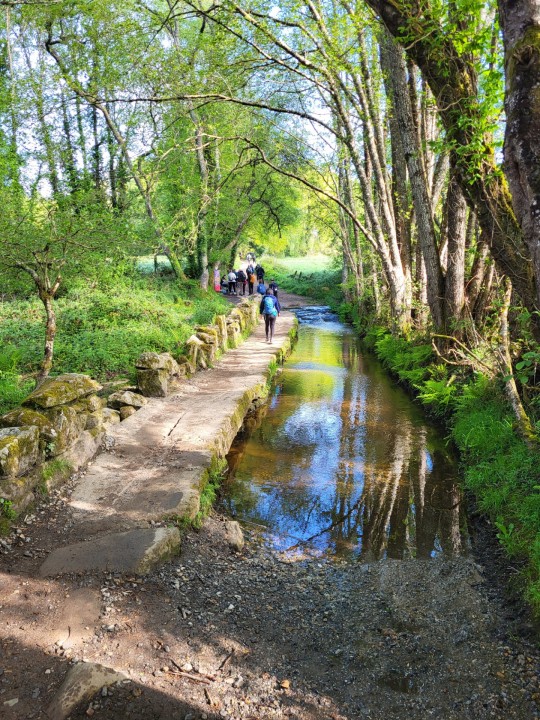

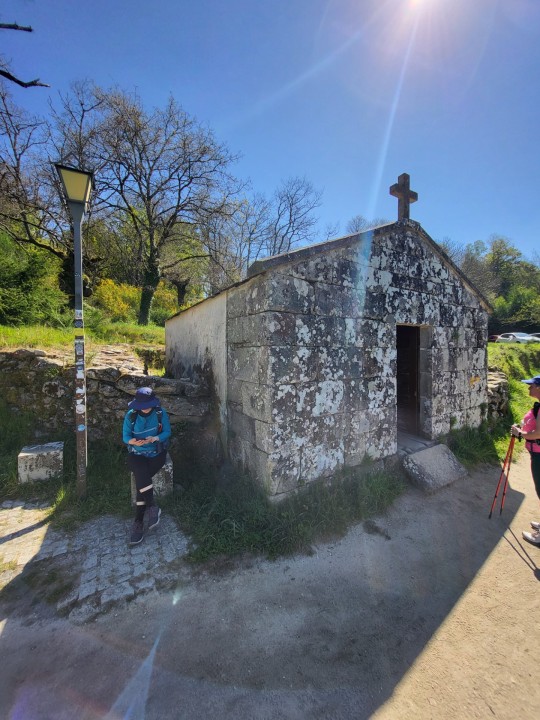


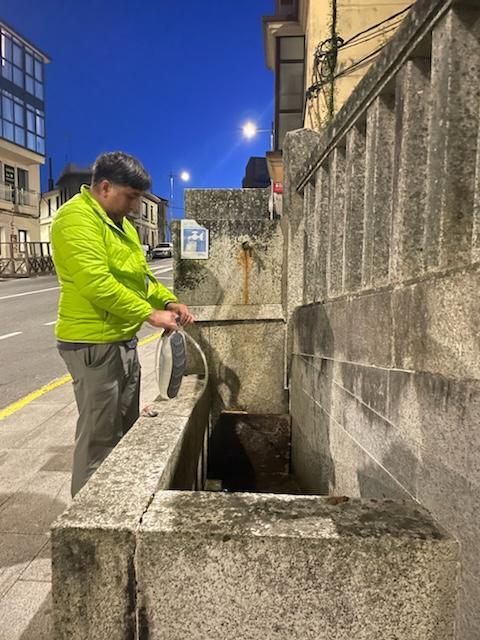
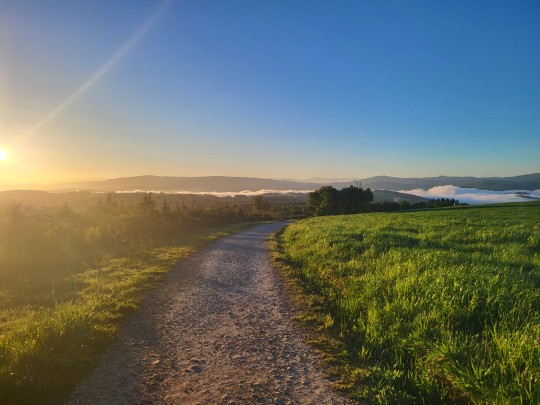

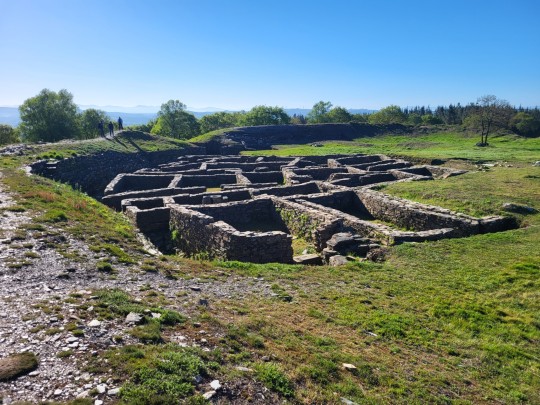
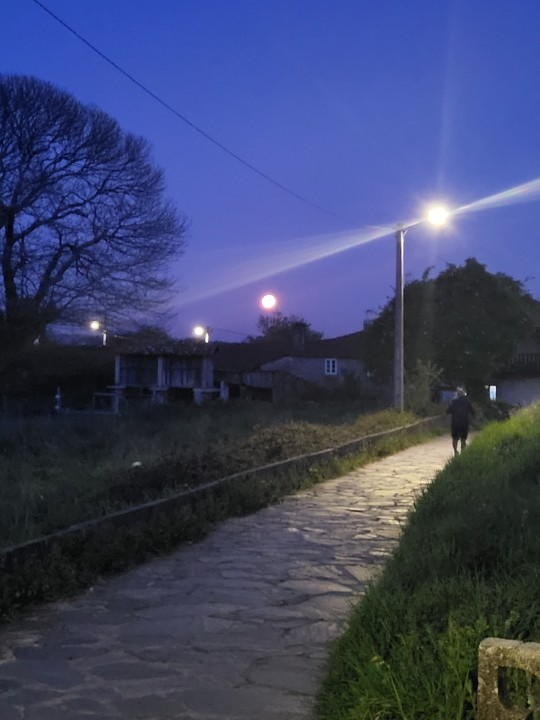
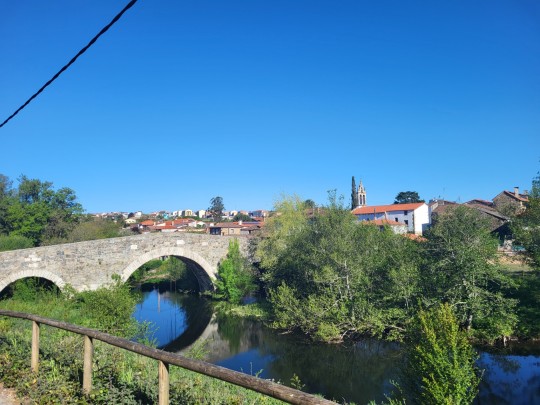
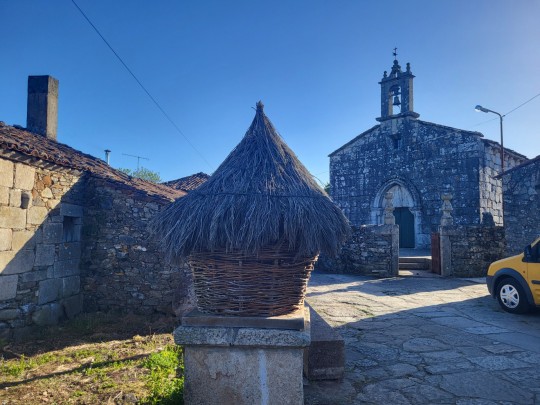
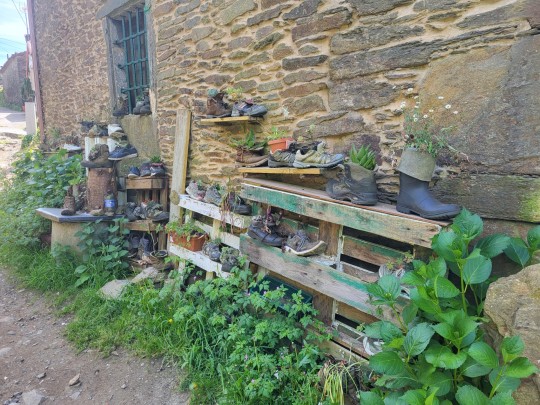

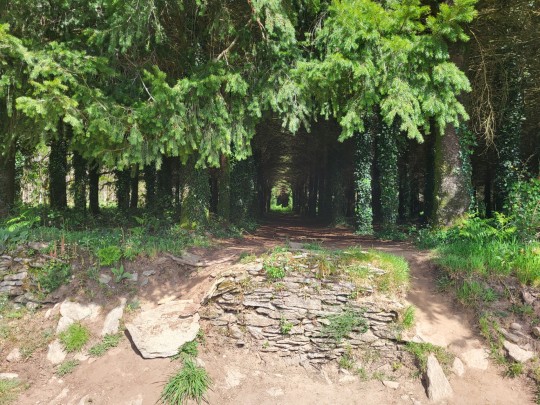

En El Camino: Our Pilgrimage to Compostela. (part 1)
Wendi and I took the ancient medieval pilgrimage to the famed Cathedral of Santiago de Compostela in Galicia Spain. It was an amazing spiritual journey for us as we traversed the beautiful Spanish countryside with other pilgrims from many different places but mostly from Spain (we assume that early and perhaps late in the season is when locals make their pilgrimage while the tourist community from come in peak season).
The term "pilgrimage" is both literal and allegorical. We literally went through a journey from Sarria to Compostela, a 117 km walk where we stopped at 5 towns along the way.
Sarria to Portomarin
Portomarin to Palais del Rei
Palais del Rei to Arzua
Arzua to Amenal
Amenal to Compostela
The literal journey brought us to a holy place, the Cathedral of Santiago de Compostela where the bones of the Apostle St. James are interned. I will reflect more on the Compostela experience in the next post.
But there is also an allegorical aspect to the concept of "pilgrimage" that is deeply important. The pilgrimage serves as a symbolism for the journey of life. As the Pilgrim's Museum stated:
The physical effort required to reach the pilgrim's goal is interpreted as a metaphor for the human spiritual journey, full of sacrifices, abnegation and heartache. Depending on the particular belief system one adheres to, the object of pilgrimage is to reach the highest level of knowledge, spiritual renewal, glory, paradise or eternal salvation.
I am glad I took these pictures (although I felt like such a tourist) because after you reach your goal I notice that the journey itself becomes a blur, as with life. For the pilgrimage to serve a full effect you need to journal about the path itself and my journal includes the images that remind me of what we saw and experienced. Let me share with you what I experienced in the pictures above.
The Chapel at the edge of Sarria: so this was at the beginning of our journey. As you left the town you see this old chapel that served a purpose in dismissing pilgrims as they started their journey. The chapel is a reminder of small holy sites that allow us to be close to God and to find meaning along the journey. There are many towns along the way and often you would find these churches that offer rest and resources like water that are essential for the pilgrim's journey.
The path along a stream: The path changes through the way. At times you are on rough gravel shielded by the forest, other times you share the open road where there is no shield from the sun or the elements. Here we had the pleasure of walking through a stream which felt very peaceful as you heard the cool water going past you. This was a very peaceful experience along the way.
The old stone bridge: Rivers and creeks run through the path and these old stone bridges were built to help the pilgrim traverse them. The bridge is now just part of the path itself and it easy to forget the amazing contribution that it offers. But the fact is that they were built for us pilgrims ages ago. These are infrastuctural designs that we can now take for granted but which have to also recognize as a social program that a community built to ease our path through difficult terrain. There is beauty and grace in these infrastructural systems that sometimes we need to recognize and appreciate.
The little Chapel on the path: Here on the path, we also find these little humble chapels that give us the opportunity to again rest and pray. This little chapel is cute and very humble with just a few hanging pictures inside but it serves a peaceful purpose along the way.
Livestock and farmers: The community along the path are made up of simple farmers and livestock handlers who share the road with us. Sometimes they greet you but more often than not they just ignore you are gaze at you wondering what exotic story you may have. This region is known for its cheese and there were many cows and sheep (and we were often greeted with a strong smell of manure) that either lay, walk, or graze along the way. Our way of life is dependent on the contributions from these animals and farmers and this again is something we also need to appreciate.
The narrow gorge: We had the opportunity to stay on the historical path or take an easier detour. We stayed on the historical path and chose to go through the narrow and steep gorge that brought us to town or Portomarin. It was not difficult for us as we enjoy hiking through rock scramblers but it is a reminder of the narrow twist and turns along the way that life gives you.
The water fountain: In almost every community, like this one at Palais del Rei, offer pilgrims access to the most essential resource for us humans. Part of our daily preparation was to fill up our water bottles or reservoir for the day's journey. As you can see I was up before dawn getting our stock ready. Throughout life we need to be ready to go on the path we are given and we need to be attentive to to these essential resources.
A misty dawn: Here, along the path, we woke up to a very misty fog that covered us before the morning sun hit us. Once the sun did shine you could see the mist retreating and the path is made clear once again. We often need to walk in the darkness and mist that is a part of our journey but we know that the sun will, at some point, bless us with its light and help us to clearly see where we need to go.
The Roman Ruins: pictures 9 and 10 highlight the amazing ruins of an ancient Roman town that was built atop of the hill in Galicia. The placement is rather obvious, on top of the hill where it has command of the high ground and can be vigilant with the Celtiberian community that would challenge now and again. We have an historical context that is an important part of our own identity. It is valuable for us know where we have come from and to learn the lessons of our past as we journey to our own future.
The moon greeting us as we begin the day's journey: It may not be easy to see but the light in the middle of this early morning picture is brilliant moon that lighted our path. It was an impressive site that kept us company as we left the town of Palais. When we first saw the moon it appeared huge and we kept our gaze on it until it finally set beyond the horizon. For a time however we felt that it accompanied us as we began that day's journey. At the end of that day, when we entered Arzua, we were greeted again by the moon and we thanked it for accompanying us on the beginning and end of the journey on that day.
The Bridge entering Melida: We found that many towns, like this one that we stopped along the way to Arzua, were often connected to rivers (some large and others small) that brought resources to the community. There is a delightful beauty in the way that a town develops itself and it is amazing to see the forces of economic and social development as it has for many years when old communities like this one formed.
The quiet beauty of a small Medieval town: Leaving Arzua we past by this smaller town which was very old and simple. Here again you can see an old church and a quaint old stone buildings (some empty and others still in use) This basket just sat there to hold offerings it seemed in front of the Church. There is something very simple and idyllic about towns such as this. Something peaceful and timeless. if I had time I would go in to meditate within the church but alas, the journey called me forth.
Planter Boots: I thought it was amazing that in this other town a community took up old and worn boots and transformed them into planters. I thought that this was an ingenious way of symbolizing the path. New life springs forth from the boots that take us through life's journey. At some point they may retire from their initial function but even in then they can be source of new an unexpected life.
A much-needed Coffee Break: Here we are stopping at a cafe in one of these small towns along the way. The cafe allowed us to enjoy a cafe con leche and some crackers that gave us the energy we needed before we continued on our way. These are necessary breaks that we need to be mindful of as we need to the refresh ourselves every now and then before we continue on our way.
The mystical forest: Now and then something mystical can be found in the book of nature. I certainly felt something mystical when we encountered this forest which invited me to enter into its natural portal which you can see beyond the broken stone wall. This forest reminds me of a quote we saw from Martin Buber, a Jewish mystic who famously said "all journeys have secret destinations of which the traveler is unaware."
A Church offering the sello: Larger medieval churches would give pilgrims an opportunity to learn about the role of the Church and aspects about the faith. After leaving Amenal I entered two churches to receive that seal which we put on our camino passport (I will show you mine in the next post). Often times these churches can offer some insights along the journey.
The World is a book and those who do not travel read only one page - St. Augustine.
0 notes
Text

Thank you to everyone who got me to 100 likes!
0 notes
Text
Work Authorization for Migrants
In a recent post I argued against a series of lies and misinformation including the idea that Immigrants are stealing American jobs. The fact is that no, they are not stealing jobs. As former labor secretary Robert Reich had said, "The surge is not increasing unemployment as undocumented immigrants or asylees are not taking jobs that Americans want." More recently I mentioned the fact that six of the construction workers who died with the Baltimore Bridge collapse were all immigrants. This was a tastimony to a study recognizing that Hispanic workers are more likely than other racial and ethnic groups to die on the job, according to the U.S. Bureau of Labor Statistics, with construction being a particularly deadly industry.
The morning report above goes further into this issue and here we hear from the New York Hospitality Alliance which is desperatly looking for immigrants who are willing to fill up these jobs. Andrew Rigie from the Alliance is asked where the holdup is.
The holdup is basically the federal government, we need the federal government to take action and make it easier for people to come and fill these jobs. Its not like they're displacing New Yorkers, displacing Americans from working in their jobs. These are open jobs and it will contribute to our local economy and our national economy. - Andrew Rigie, The New York Hosptiality Alliance
The migrants I see are all looking for work opportunities. They are open to jobs that many people would rather not work. And yet they need the money for financial issues they have back home including:
Paying smugglers who are holding family members at the border.
Paying back family members who contributed an initial investment so they could find opportunities.
Paying debts owed to labor traffiking rings
Sending much needed money to the medical or social needs of family members left behind.
Many migrants have these financial burdens. It isn't even an issue of wanting a better life, many people have desperate situations that cause them to leave and this usually includes making an initial investment to migrate to the United States where they hope to achieve some form of social stability and perhaps achieve some meagre economic opportunity.
Pope Francis urges us to promote the social integration of migrants as we consider developing a more Christian-based economy that is consistent with our social principles:
With immigrants, take this path of integration into society. It is not a work of charity to leave immigrants where they are. No. Charity involves taking them and integrating them, with education, with job placement, with all these things.
In 2021 Pope Francis would also approach this theme and suggest that there are four steps that society should do in responding to the immigrant community.
In light of the Latin American experience, I was able to affirm that "immigrants, if they are helped to integrate, are a blessing, a wealth and a new gift that invites a society to grow" (FT, 135). Welcoming, accompanying, promoting and integrating, the four steps. If we don't achieve integration there could be problems, and serious ones.
The serious problem that Pope Francis alludes to here is the social ramifications that happen when any group is socially sidelined or oppressed and begins to organize against the system. We have seen this in our nation and the movie industry has portrayed this to us (e.g. Gangs of New York) so we cannot be ignorant of what our Holy Father is saying here. Instead of waiting for serious problems to develop let us take the initiative to welcome the new arrivals and see how they can help develop the economic blessings that both of our communities need.
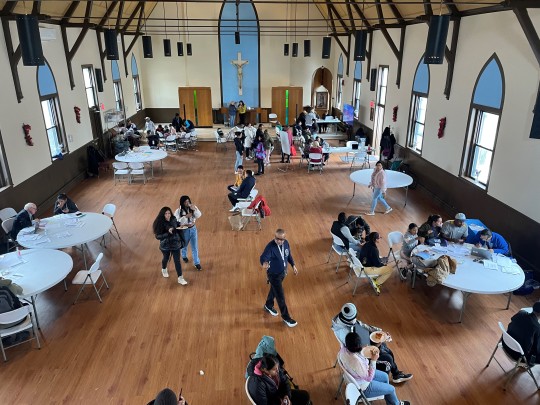
0 notes
Text
Celebrating Dignity and Creating a Culture of Encounter
The Vatican recently shared a new document expanding our understanding of human dignity. The Church made certain distinctions on this principle. It recognizes the ontological dignity that we all have but it also identifies the people need to experience Social Dignity: That is, the dignity that is measured on how we are seen and treated in society. Some people are treated in undignified ways as they suffer from social discrimination or violent oppression, misused by those with power who are perverting their moral dignity. In discussing this distinction the Church raised the following issue
The Travail of Migrants: It is urgent to remember that “every migrant is a human person who, as such, possesses fundamental, inalienable rights that must be respected by everyone and in every circumstance.” Receiving migrants is an important and meaningful way of defending “the inalienable dignity of each human person regardless of origin, race or religion.”
We have experienced these migration trends starting in July of 2022 when the asylee community was bused to our city in the midst of the dysfunctional political battle over this issue. As a result a misinformation campaign emerged to sow division and fear over this community with regards to these new arrivals. Our Catholic Charities team is seeing about 200 migrants a week and what we witness is extreme poverty and brutal hardship. The conservative media is making it seem that the government and agencies like our own are giving tremendous financial assistance that rewards new arrivals while poor Americans (and lets be honest, the conservative media has never cared about the poor but they love to pit them against others) struggle with no assistance. Such misinformation includes:
Biden sign an Executive Order (9066) that gives migrants who illegally enter US $5K visa gift cards? No! This did not happen
That NYC and the Adams administration is offering credit cards or exorbitant debit cards are given to these new arrivals. There is a discussion to issue debit cards as a possible replacement for non-perishable food boxes the city currently provides to migrants. They would be loaded with an average of $12.52 per person, per day for 28 days.
Some other misinformation includes:
Biden does not want to secure the border: NO! Republicans have actually voted to cut spending bills on border security and infamously blocked passage of the 106 Billion National Security Supplemental that included 14.5 Billion for Border funding.
Drug Crisis is resulting from Migrants: NO! 90% of drugs that come from acroos the border have come through official ports of entry. 86% of people convicted of traficking fentanyl are U.S. citizens.
Undocumented Migrants are terrorist: NO! No terrorist attack has been committed by somebody who crossed the border illegally in the last 50 years.
Immigrants are stealing American jobs: NO! The surge is not increasing unemployment as undocumented immigrants or asylees are not taking jobs that Americans want. The 6 construction workers who died with the Baltimore Bridge collapse were all immigrants and they are a witness to studies recognizing that Hispanic workers are more likely than other racial and ethnic groups to die on the job, according to the U.S. Bureau of Labor Statistics, with construction being a particularly deadly industry.
Blame crime on Immigrants: NO! A 2020 study found that undocumented immigrants have substantially lower crime rates than native born citizens and legal immigrants. Americas homicide rate has fallen 13% since 2022, notwithstanding the immigration surge. Local law enforcement agencies are reporting drops in other violent crimes.
As these migrants do not have access to the benefits that Americans do have attempting to pit one group (Veterans, the poor) against another (the migrants) is completely insincere and unjust. $12.52 is pittance here in NYC, it just allows us to help them sustain themselves, these are families who live in shelters and have nothing beyond a backpack that they call there own. They are desperately trying to work in order to become sustainable and to obtain some semblance of stability. It is good that the city offers these meagre assistance but it is criminal for the media (typically from the right) to intentionally spread falsehoods in order to spread fear, hatred, and sow division.
When the encyclical Fratelli Tutti was introduced in 2020 Pope Francis addressed the global challenges of the Covid-19 Pandemic. Since then, however, we have experienced ongoing economic instability in many nations that have exacerbated migration trends from the global south to the north. These economic instabilities exist in the northern hemisphere with recession, increased debt and mass inflation. We add to this the further development of social conflicts and war that are also part of our current reality.
Indifference allows us to ignore these global social challenges to focus on our own situation. We somehow think that the global reality does not impact us, or, we believe that we can close off the borders and keep ourselves protected from the effects of globalization (while somehow ignoring the fact that our entire economy is completely dependent on the global economy). Pope Francis calls on us to challenge the globalization of Indifference. The solution he proposes to us Catholics is to develop a “culture of encounter”.
To speak of a “culture of encounter” means that we, as a people, should be passionate about meeting others, seeking points of contact, building bridges, planning a project that includes everyone. This becomes an aspiration and a style of life. The subject of this culture is the people, not simply one part of society that would pacify the rest with the help of professional and media resources. FT #216
In promoting a culture of encounter Pope Francis qualified this further when he discussed the need to promote a Christian-based economy:
With immigrants, take this path of integration into society. It is not a work of charity to leave immigrants where they are. No. Charity involves taking them and integrating them, with education, with job placement, with all these things.
This is the teaching that guides the way we at Catholic Charities are responding to this crisis and this situation.
On Sunday, March 17, I had the pleasure of attending a Mass with both Bishop Seitz from El Paso, Texas, and our own Bishop Nicolas DiMarzio from Brooklyn. Bishop Seitz reflected on the words of the prophet Jeremiah and suggests that immigrants are social prophets for the issues of the world today.
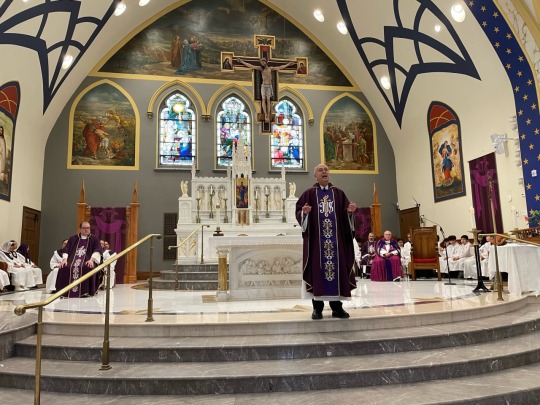
“They are like the canaries in the mine,” Bishop Seitz goes on to say, “they give the signal to the world that when they have to leave their homes and families, they point out challenges in the world that require justice and our response.”
He goes on to say that “When they are forced to leave this is a signal for us to engage the love of God in responding to the social challenge that love demands from us.”
Reflecting on the gospel, Bishop Seitz tells us that “Jesus says that we must be like the seed that dies to itself so that the Lord can begin something new, a new growth. In this way migrants live like our Lord Jesus preaches, in this way they follow his example of dying to one’s self and preparing themselves and the world for something new.”
Bishop Seitz reminds us that “We are all immigrants, it’s just that most of us have forgotten this truth. But we must acknowledge and live this truth so that the Lord can make, through us, a better and more just world. As Jesus commands us too.” After the Mass Bishop Seitz and Bishop DiMarzio He went to visit some of our migrant programs and talk with members of the migrant community. This is exactly what the "culture of encounter" is all about; being able to come face the face with those who are suffering and accompanying them on their harrowing journeying through life. This is where we, the Church, are called to be.
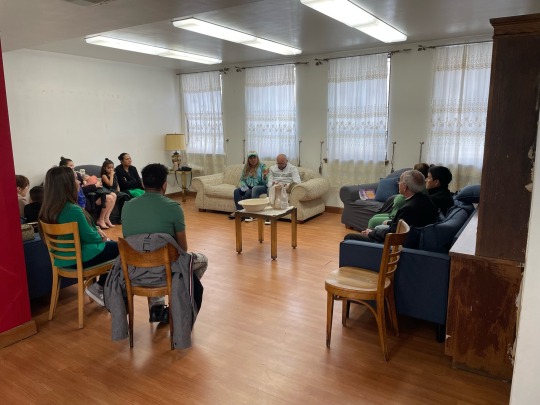
0 notes
Text
Inequality For All
youtube
The issue of poverty and economic justice has always been part of the Church's social concern. Not only is this with regards to the publication of Rerum Novarum and the birth of Catholic social teaching when Pope Leo XIII shared the Church's concern regarding the plight of workers and the rights they should have. This social concern goes right to the time of Jesus who saw it as his responsibility to heal and feed those who were poor and marginalized.
The YouTube movie by Robert Reich, "Inequality For All," goes into the economic history of the United States reviewing the policies that allowed us to grow the middle class in America from 1947 to 1979. It then looks into the shift and pro-corporate and anti-poverty policies that had the opposite affect, what the graph below calls "the Great Regression."
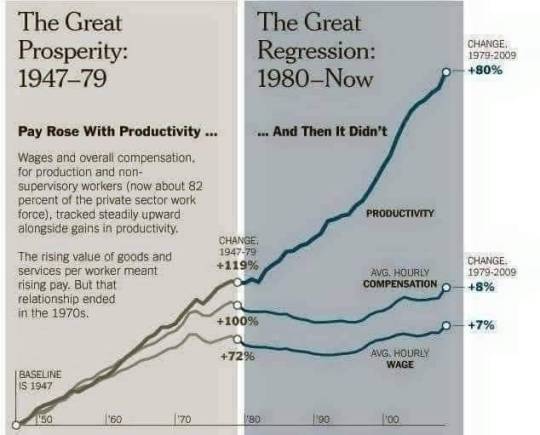
There are a number of posts that I have developed that goes into this issue, both from the Catholic concern and from the standpoint of economic policies. These include:
Why Inequality Persist in America (with links to past posts)
USCCB on Income Inequality
The Global Solidarity Fund, a Christian Economic Model
The simple point that has to made (over and over again it seems) is that the social programs we had after World War II, the economic model that was based on a Keynsian capitalist system (which people will now erroneously call socialism/communism), is when we experience a booming economiy that helped develop the middle class.
Just to clarify a definition: The keynsian capitalist system generally advocated for a regulated market economy. The proposed regulations focused on the corruptive activity of the private sector and it allows the government to have an active role as it intervenes during recessions and depressions. Recognizing that an unregulated market economy can, and has become, volatile and unstable this can be mitigated by economic policy responses coordinated between government and central bank. In particular, fiscal policy actions taken by the government and monetary policy actions taken by the central bank, can help stabilize economic output, inflation, and unemployment over the business cycle.
Pope Francis has expressed the concern about this as a global economic phenomenon which is why he has been promoting the Economia De Francesco Model to reveiw this push to deregulate the global economy and to widen the gap between the wealth minority (the 1%) and the rest of us.
While the income of a minority is increasing exponentially, that of the majority is crumbling. This imbalance results from ideologies which uphold the absolute autonomy of markets and financial speculation, and thus deny the right of control to States, which are charged with providing for the common good. A new, invisible and at times virtual, tyranny is established, one which unilaterally and irremediably imposes its own laws and rules.
The Preferential Option for the Poor is the Catholic principle that always places economic injustice in check. Bishop Barron offers a good articulation of this principle in this other post.

The movie link is below but I think you have to open this on a seperate window. The movie was made ten years ago but the research is still very relevant as it defends the need to promote the socio-economic policies we desperately need to promote a middle class economy.
youtube
If the link does not work place this on a webpage: https://youtu.be/zvAFPHLFMa0?si=CtXlItq45bfsEkUb
0 notes
Text
Vatican says surrogacy and gender theory are 'grave threats' to human dignity : NPR
I posted on the document in question, "Dignitas Infinita," a declaration on human dignity that raises issues both old and new but very much important in the world of today.
It is correct for the Vatican to address this within the lens of human dignity since that is the principle that this issue impacts. I wrote about this issue recently in another post, but the NPR commentary adds to this conversation.
Admittedly, the issue that is being highlighted is one that has not been addressed in the past but which has definitely emerged and must be considered the issue of gender theory and sex change. I believe there is a legitimate concern about how this position impacts the LGBT issue (with obvious implications on the transsexuals or non-binary community), and as I suggest to my students this is exactly why the Church's position on social issues never go beyond the status of undefined doctrine, because it recognizes the need to continually engage in dialogue on these issues and reshape its position.
But, from my own analysis and reading of the official Catholic position, I will say what I believe the position to be. This, of course, will reflect my earlier post. Behind all these issues is a theology of gift, gratuitousness. All life emerges as a gift inherently imbued with dignity, which we Catholics/Christians ascribe to God. The document goes on to qualify the biblical statement of being made in the image and likeness of God to assist in our understanding of the principle of gratuitousness and dignity.
Every individual possesses an inalienable and intrinsic dignity from the beginning of his or her existence as an irrevocable gift. However, the choice to express that dignity and manifest it to the full or to obscure it depends on each person’s free and responsible decision. Some Church Fathers, such as St. Irenaeus and St. John Damascene, distinguished between the “image” and “likeness” mentioned in Genesis. This allowed for a dynamic perspective on human dignity that understands that the image of God is entrusted to human freedom so that—under the guidance and action of the Spirit—the person’s likeness to God may grow and each person may attain their highest dignity.
So, nothing that is created is a mistake or, in some way, evil. This is a gnostic position that the Church has clearly repudiated. People are born with their God-given orientation, passions, and desires that shape who they are and how they will contribute to the redemptive mission of transforming our society and world. These passions, desires, and orientations are all good, so long they are oriented to their ultimate fulfillment, building the Kingdom of God and in service to the recognition of God's love for all, valuing the dignity and rights that this entails, and the development of the common good of all (based on a healthy tension of solidarity and subsidiarity) based on this principle.
Based on this premise. People born with a homosexual orientation must be valued not only for their individuality but also for their God-given orientation. This is not seem as a choice but as a passion that they were imbued with. The work here is not to ever suggest that a mistake was made but to see how this can serve the community and the fullfilment of the Kingdom of God, Jesus' mission. The Church tackled the question of orientation in the document "Always our Children" where it says:
In light of this possibility, therefore, it seems appropriate to understand sexual orientation (heterosexual or homosexual) as a deep-seated dimension of one’s personality and to recognize its relative stability in a person. A homosexual orientation produces a stronger emotional and sexual attraction toward individuals of the same sex, rather than toward those of the opposite sex... Generally, homosexual orientation is experienced as a given, not as something freely chosen. By itself, therefore, a homosexual orientation cannot be considered sinful, for morality presumes the freedom to choose.
But the issue of gender ideology and sex change stands as an affront to this premise because it does suggest that the way they are born is in fact a mistake that they may change if they wish. Thus the idea of altering ones sexual state or nature based on ideological struggles and confusions that do not conform to social norms are seen as struggles that violate this very principle.
Teaching about the need to respect the natural order of the human person, Pope Francis affirmed that “creation is prior to us and must be received as a gift. At the same time, we are called to protect our humanity, and this means, in the first place, accepting it and respecting it as it was created.” It follows that any sex-change intervention, as a rule, risks threatening the unique dignity the person has received from the moment of conception.
To me there is a consistent ethic that is being presented here regarding how we conceptualize the dignity of the human person. This presentation forces us to not simplify any arguement regarding this principle but to struggle with the details of how we can ultimately recognize the principle of gratuitousness and dignity.
The context of this dignity is found in the community. Our individual dignity is based on the gift we received from the family and the gift of our contribution to the community. We are each individuals who are created with dignity that can serve our communities with the gifts of our passions, desires, and relationships.
It is unfortunate that families and society can sometimes have us question our own gifts. Our own commercial and material activities can also play into this and have us believe that sex change and gender altering surgeries or augmentations are mere economic choices that can help achieve true social conformity and happiness. The Church tells us that this is not the case. Again, we are not born a mistake. We are made in the image and likeness of God, and this is what the Church wants us to recognize.

0 notes
Video
youtube
New Vatican document lists ‘grave violations’ of human dignity
The Vatican launched a new document this past week. The document outlined the dignity of the human person and the violations to this principle. The Document is called “Dignitas Infinita.” This document is published as a Declaration that defines (and perhaps updates) the fundamental principle of Catholic social teaching, the Dignity of the Human Person.
Much is being said about the focus on how this document is treating the issue of gender ideology but narrowing its focus on this one issue is a disservice to the purpose of this document. Certainly this document looks at new issues that had not been treated before but the way it is written attempts to reflect on a number of important issues within this principle. The document begins with the principle itself and offers a nuance that connects it with the Preferential Option for the Poor.
Every human person possesses an infinite dignity, inalienably grounded in his or her very being, which prevails in and beyond every circumstance, state, or situation the person may ever encounter. This principle, which is fully recognizable even by reason alone, underlies the primacy of the human person and the protection of human rights. In the light of Revelation, the Church resolutely reiterates and confirms the ontological dignity of the human person, created in the image and likeness of God and redeemed in Jesus Christ. From this truth, the Church draws the reasons for her commitment to the weak and those less endowed with power, always insisting on “the primacy of the human person and the defense of his or her dignity beyond every circumstance.”
A important clarification on this principle is then offered. There are four aspects to this value that must be seen and treated differently in order to recognize the complexity of how people see, recognize and at times misuse their sense of human dignity.
Ontological Dignity: The basis of the inalianable dignity that we all have as creation that is made “in the image and likeness of God.” This is the dignity that we all have and it never leaves us.
Moral Dignity: The dignity of how we exercise our freedom and form our conscience. Our dignity to employ our free will and act. There is dignity in how we act but our actions may not be well oriented.
Social Dignity: The dignity that is measured on how we are seen and treated in society. Some people are treated in undignified ways as they suffer from social discrimination or violent oppression, misused by those with power who are perverting their moral dignity.
Existential Dignity: People who suffer from mental anguish and conditions that do not allow them to recognize their own dignity. They struggle because of “serious illnesses, violent family environments, pathological addictions, and other hardships.”
The declaration then goes on to promote the theological premise for this fundamental principle. The basic premise is the belief that we are “made in the image and likeness of God” and that Christ reconciles this dignity in his own salvific mission to humanity. The mystery of the incarnation allows us to not only recognize the dignity of Christ but of all humanity.
The Declaration then goes on to name the issues after asserting the concept of basic human goods and intrinsically evil acts: the moral underpinginings for expressing one’s dignity. This, of course, leads to the following list:
The Drama of Poverty: “One of the phenomena that contributes significantly to denying the dignity of so many human beings is extreme poverty, linked as it is to the unequal distribution of wealth... The “‘scandal of glaring inequalities’ continues,” where the dignity of the poor is doubly denied because of the lack of resources available to meet their basic needs and the indifference shown toward them by their neighbors.
War: “With its trail of destruction and suffering, war attacks human dignity in both the short and long term... All wars, by the mere fact that they contradict human dignity, are “conflicts that will not solve problems but only increase them.” This point is even more critical in our time when it has become commonplace for so many innocent civilians to perish beyond the confines of a battlefield.
The Travail of Migrants: It is urgent to remember that “every migrant is a human person who, as such, possesses fundamental, inalienable rights that must be respected by everyone and in every circumstance.” Receiving migrants is an important and meaningful way of defending “the inalienable dignity of each human person regardless of origin, race or religion.”
Human Trafficking: “Human trafficking is a crime against humanity.” It essentially denies human dignity in at least two ways: “Trafficking profoundly disfigures the humanity of the victim, offending his or her freedom and dignity. Yet, at the same time, it dehumanizes those who carry it out.”
Sexual Abuse: The profound dignity inherent in human beings in their entirety of mind and body also allows us to understand why all sexual abuse leaves deep scars in the hearts of those who suffer it. Indeed, those who suffer sexual abuse experience real wounds in their human dignity. These are “sufferings that can last a lifetime and that no repentance can remedy.
Violence Aagainst Women: Violence against women is a global scandal that is gaining increasing recognition... There is an urgent need to achieve real equality in every area: equal pay for equal work, protection for working mothers, fairness in career advancements, equality of spouses with regard to family rights and the recognition of everything that is part of the rights and duties of citizens in a democratic State.” The time has come to condemn vigorously the types of sexual violence which frequently have women for their object and to pass laws which effectively defend them from such violence.
Abortion: The Church consistently reminds us that “the dignity of every human being has an intrinsic character and is valid from the moment of conception until natural death... It must, therefore, be stated with all force and clarity, even in our time, that “this defense of unborn life is closely linked to the defense of each and every other human right. It involves the conviction that a human being is always sacred and inviolable, in any situation and at every stage of development.
Surrogacy: [Pope Francis] deems deplorable the practice of so-called surrogate motherhood, which represents a grave violation of the dignity of the woman and the child, based on the exploitation of situations of the mother’s material needs. A child is always a gift and never the basis of a commercial contract.
Euthanasia and Assisted Suicide: Helping the suicidal person to take his or her own life is an objective offense against the dignity of the person asking for it, even if one would be thereby fulfilling the person’s wish: “We must accompany people towards death, but not provoke death or facilitate any form of suicide. Remember that the right to care and treatment for all must always be prioritized so that the weakest, particularly the elderly and the sick, are never rejected. Life is a right, not death, which must be welcomed, not administered.
The Marginalization of People with Disabilities: The question of human imperfection also carries clear socio-cultural implications since some cultures tend to marginalize or even oppress individuals with disabilities, treating them as “rejects.” However, the truth is that each human being, regardless of their vulnerabilities, receives his or her dignity from the sole fact of being willed and loved by God. Thus, every effort should be made to encourage the inclusion and active participation of those who are affected by frailty or disability in the life of society and of the Church.
Gender Theory: All attempts to obscure reference to the ineliminable sexual difference between man and woman are to be rejected: “We cannot separate the masculine and the feminine from God’s work of creation, which is prior to all our decisions and experiences, and where biological elements exist which are impossible to ignore.” Only by acknowledging and accepting this difference in reciprocity can each person fully discover themselves, their dignity, and their identity.
Sex Change: Pope Francis affirmed that “creation is prior to us and must be received as a gift. At the same time, we are called to protect our humanity, and this means, in the first place, accepting it and respecting it as it was created.” It follows that any sex-change intervention, as a rule, risks threatening the unique dignity the person has received from the moment of conception.
Digital Violence: Digital technologies increasingly tends toward the creation of a world in which exploitation, exclusion, and violence grow, extending even to the point of harming the dignity of the human person. The digital environment is also one of loneliness, manipulation, exploitation, and violence, even to the extreme case of the ‘dark web.’ Digital media can expose people to the risk of addiction, isolation, and gradual loss of contact with concrete reality, blocking the development of authentic interpersonal relationships.
As the declaration concludes Pope Francis reminds us that this is the 75th anniversary of the Universal Declaration of Human Rights and he calls on Catholic and people of goodwill to recognize these violations and consistantly defend them. It is a beautiful call to action on a principle we dare not take for granted.
Even today, in the face of so many violations of human dignity that seriously threaten the future of the human family, the Church encourages the promotion of the dignity of every human person, regardless of their physical, mental, cultural, social, and religious characteristics. The Church does this with hope, confident of the power that flows from the Risen Christ, who has fully revealed the integral dignity of every man and woman. This certainty becomes an appeal in Pope Francis’ words directed to each of us: “I appeal to everyone throughout the world not to forget this dignity which is ours. No one has the right to take it from us.”

0 notes
Text

I was finally given the opportunity to obtain and read Thomas Merton's autobiography, "The Seven Storey Mountain." This is an amazing story of one man's search for truth and wisdom in the mid-20th century. It's a great read for anyone who is a seeker of philosophical/theological truths and who is non-judgementally open to the experiences of the world.
Merton eventually becomes an ascetic monk, but this lifestyle does not remove him from the experience and beauty of the world. He passionately absorbs the world and the relationships he develops. Initially, he is a philosophical atheist who struggles to find meaning in this world; what Catholicism and monasticism eventually offer is not a departure or deprivation from this world. Instead, he is able to center himself on God, the ultimate source of Truth and Love. This allows him to balance the experience and relationships he encounters. This book is an amazing journey of one man's reflective pursuit towards truth, beauty, happiness, and meaning.
One passage I want to share in this post is in chapter three, when he undertook his personal journey as an adolescent who just lost his father. He finally encounters the world of prayer and has a mystical experience that will eventually (although not immediately) change him. At that moment, he encounters sacred scripture. Until then, he enjoyed the poetic and philosophical musings of D.H. Lawrence whose religious exposition was tainted by a right-wing political affiliation. Evidently, this author was in favor of dictatorship and social order. This ideological orientation would color his religious lens. Merton recognizes this after he finally reads the Bible for the first time and sees this poet's fallacy. As Merton describes it:
One evening, when I was reading these poems, I became so disgusted with their falseness and futility that I threw down the book and began to ask myself why I was wasting my time with a man of such unimportance as this. For it was evident that he had more or less completely failed to grasp the true meaning of the New Testament, which he had perverted in the interest of a personal and home-made religion of his own which was not only fanciful, but full of unearthly seeds, all ready to break forth into hideous plants like those that were germinating in Germany's unweeded garden, in the dank weather of Nazism.
This passage highlights for me the concern I have for the emerging Christian nationalism that Merton saw developing in Europe of the mid 1930's. His journey towards the truth is to be free of the ideological perversions that filter religious interpretation and to read the joy of the Gospel himself in order to authentically find God in the story of Jesus, the story of service, healing, forgiveness, and reconciliation. This is not the Gospel narrative of Christian nationalism.
The purpose of Christianity is to find the deepest meaning of who you are by connecting oneself with the source of both our entire being and the whole of creation. Scripture and the beauty of our tradition imparts this wisdom on us. Do not let the perversion of Christian nationalism and its hatred for our diverse world defile the beauty of our Christian faith and the movement that Jesus and the early church started. Take time to go to the source and rediscover what it means to truly be a disciple of Christ.
May the wisdom of Merton's experience be a spiritual guide for us in these troubled times.

2 notes
·
View notes
Video
youtube
The Vatican's Ethical Vision for Artificial Intelligence
The 2024 World Day of Peace Message from the Vatican expressed a social concern on the challenges of Artificial Intelligence. The 2024 World Communications Day Message from the Vatican continued to examine this concern especially with the way that AI has been used to warp the field of communications and social messaging. The concern that was raised is captured in the above video and comedian Jon Stewart adds his own thought on this in the Daily Show. The concern is primarily in how AI can be used to warp reality further. As the message suggests:
[Artificial Intelligence] can be a source of “cognitive pollution”, a distortion of reality by partially or completely false narratives, believed and broadcast as if they were true. We need but think of the long-standing problem of disinformation in the form of fake news, which today can employ “deepfakes”, namely the creation and diffusion of images that appear perfectly plausible but false (I too have been an object of this), or of audio messages that use a person’s voice to say things which that person never said. The technology of simulation behind these programmes can be useful in certain specific fields, but it becomes perverse when it distorts our relationship with others and with reality.
Artificial Intelligence is not a futuristic sci-fi dream that many of us had in the 1980′s. AI is part of our lived reality and this means that we must take the time to consider the ethical implications now. The appeal being to direct AI and other technology to a “human-centred, ethically grounded and directed toward the good.”
youtube
More recently, The United Nations has expressed great concern over Israel’s use of artificial intelligence to pick targets. The Secretary-General of the UN, Antonio Guterres, had this to say about this specific issue.
I am deeply troubled by reports that the Israeli military’s bombing campaign includes AI as a tool in the identification of targets, resulting in a high level of civilian casualties. AI should be used as a force for good to benefit the world; not to contribute to waging war on an industrial level, blurring accountability.
We need to grasp the ethical dangers of AI use in how it treat the dignity of work, how we communicate with one another, and how we conduct conflicts and warfare. These are major concerns that require immediate consideration.
0 notes
Text
The loss of these immigrants demonstrates the role that the immigrant communities continue to have building the infrastructure of our great nation. The following excerpt is one that should be the dominant narrative of our immigrant workforce.
Hispanic workers are more likely than other racial and ethnic groups to die on the job, according to the U.S. Bureau of Labor Statistics, with construction being a particularly deadly industry.
"The only choice is to work, when you don't have the same salary that a citizen might earn," said Carlos Crespo, 53, a mechanic from Mexico. "Many don’t value our Hispanic community. They see us as animals or think that we live off the government. But that is not true, we pay our taxes too," he said.
Who were these workers? The following news story goes into their lives.
youtube
This is the immigrant narrative that we need to recognize. Not the criminally lazy pariah that the media tends to portray, but the hardworking families that continue to be the hands that build America.
youtube
0 notes
Text
The Story of Don Pietro Pappagallo, a martyr for Catholic Social Principles
youtube
The video above discusses many items of this past week, but i want to draw attention to the last story (feel free to move the curser to the last segment, the 27th minute) which shares the amazing story of Fr. Pietro Pappagallo. His cause for beatification is happening now, and John Allen suggests that this martyr could be seen as a Saint of Catholic Social Teaching. I certainly want to know more of his story and found this article that John Allen wrote below which goes into further detail.
In his article John Allen posted a letter from Pappagallo to Monsignor Baldelli who attempted to remove him from the ministry where he was serving the poor and immigrant communities. His response reflects the will of a Saint like Mother Cabrini who will not compromise the social gospel for any political agenda no matter how controversial.
“Monsignor, I see myself in the workers at the boarding house. They come from my land, and they’re immigrants too. The fact that they haven’t gone overseas doesn’t make their situation any less painful or difficult … The work in the factory is dehumanizing. I don’t find it just, and I can’t appease myself with arguments about politics, which don’t interest me at all. I only know that the faith, and a sense of humanity, don’t allow me to ignore my brothers, to whose service I’ve been assigned. If you’re not on their side, I can only say that I’m upset and confused.”
Like Mother Cabrini he was steadfast in his service to the victims of the Italian fascist regime and later to the Nazis. Unlike Mother Cabrini he would become a martyr during a Nazi roundup know as the Ardeatine massacre. I hope and pray that his sacrifice may serve as yet another example of Catholic Social Teaching in Action.
0 notes
Text
The school of Christ is the school of charity. On the last day, when the general examination takes place, there will be no question at all on the text of Aristotle, the aphorisms of Hippocrates, or the paragraphs of Justinian. Charity will be the whole syllabus.
The quote from St. Robert Bellarmine, SJ connects with me as a Professor of theology and ethics. I think this will be a quote that I incorporate from now on in my own syllabus. This will be a reminder to me that our academic pursuits cannot simply fulfill theoretical concepts but they must be rooted in praxis, the practical reality of our lived experience, what we in Latinx Theology call Lo Cotidiano. Famed social theorist Paulo Friere would say this about the radical nature of those who enter into the praxis of one's lived reality.
The more radical the person is, the more fully he or she enters into reality so that, knowing it better, he or she can transform it. This individual is not afraid to confront, to listen, to see the world unveiled. This person is not afraid to meet the people or to enter into a dialogue with them. This person does not consider himself or herself the proprietor of history or of all people, or the liberator of the oppressed; but he or she does commit himself or herself, within history, to fight at their side.
This also reminds me of a hard lesson that I had to learn when I went through my own Spiritual Exercises. A lesson about learning to not just believe in the love of God but to actually know it. My Spiritual Director would cite the quote below almost every week.

You will find this quote in every one of my journals.
0 notes